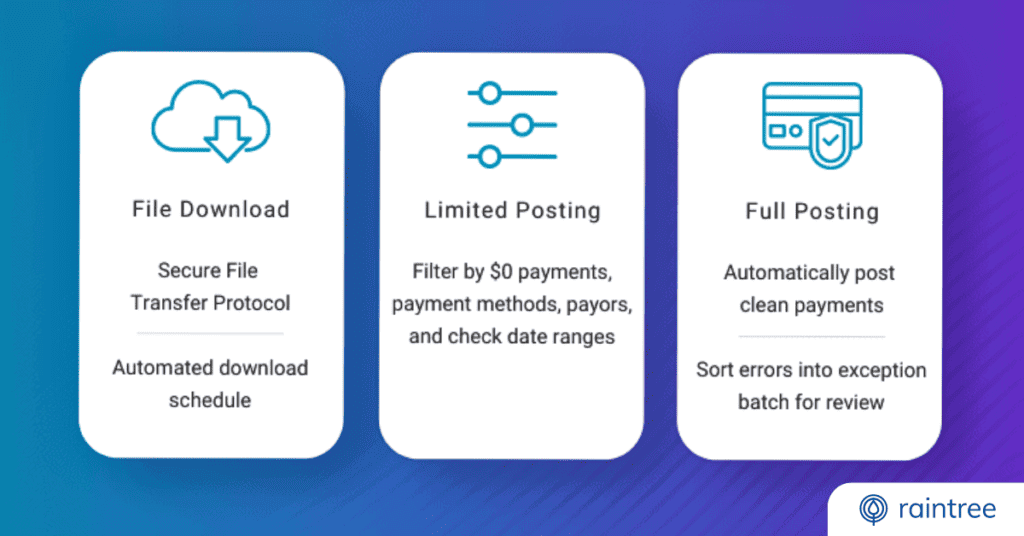
Why Your Therapy Practice Needs Automated Remittance
Running the financial side of any business isn’t easy, but therapy practices can run into way more complications than industries outside of healthcare. So when it comes to getting accurate and efficient reimbursements, there’s no reason not to use the benefits of automation!
Read on for remittance advice in medical billing for rehab and therapy providers, and three ways that automation can help!
What is Remittance Processing in Healthcare?
Remittance processing in healthcare refers to the specific handling and processing of payments and related documents within the healthcare industry. It involves the management of healthcare remittances, which are payments made by insurance companies, government payers, or patients for medical services rendered by healthcare providers, such as hospitals, clinics, physicians, and other healthcare entities.
In traditional manual remittance processing, companies receive payment documents, such as checks or payment advices, from their customers. These documents are typically processed manually, involving tasks such as opening envelopes, recording payment information, verifying details, and depositing the funds into the appropriate accounts. This manual process can be time-consuming, prone to errors, and inefficient.
What is Automatic Remittance Processing?
Automatic Remittance Processing refers to the automated handling and processing of remittance documents or payments. Automatic Remittance Processing utilizes technology to streamline and automate the handling of remittance documents.
Isn’t Therapy Payment Processing and Remittance Already Automated?
To a degree, yes. Long gone are the days when therapists had to manually review every single claim before dropping them off at the post office. But even current revenue cycle processes still have a degree of manual labor to them. By automating payments and remittance posting, we enable reduced human error, streamlined financial workflows, and most importantly – fewer delays that can drag out payment processing and further complicate healthcare billing processes.
What Does a Modern Remittance Posting Process Look Like?
With 89.9% of office-based practices switching to digital electronic medical record (EMR) software, manual processes don’t look like they used to! Rather than taking out a pen, calculator, or Rolodex, users who handle payment posting can simply log in to their chosen virtual clearinghouse and download remittance files from there.
After obtaining those files, users need to upload them, either one by one or in batches, to their EMR so that they can be processed and scanned for errors. Only then can the remittance files move on to payment posting, or in the case of an error message, go through the time-consuming process of being reviewed, corrected, and resubmitted to the clearinghouse.
Our Payment and Remittance Advice: 3 Stages to Automate
While manual remittance posting seems like a dream compared to more archaic processes, technology has given us the tools to speed up remittance processing and posting even further, with fewer claim denials than ever!
To better understand how remittance can be streamlined, let’s review the three stages where remittance can allow more automation: File Downloads, Limited Posting, and Full Posting.

1. File Downloads
With the advent of secure file transfer protocol (SFTP), sending sensitive data between entities has become a common practice. So why not leverage that for our remittance? By synchronizing a virtual clearinghouse that allows SFTP to our EMR, we can eliminate the need to manually download, upload, and scan remit files.
To take it a step further, automated file downloads can offer some customization as well. If we want to see real-time updates while remaining mindful of our current workloads, then file downloads can be set to automatically run every few hours. In instances where the workload is light or we need to prioritize a certain batch of remit files, we can still manually select the files we want to download without interfering with the established download schedule.
2. Limited Posting
Sometimes it’s more efficient to filter remit files as they come in! By utilizing limited posting, we can filter what remit files we would like to process, fast-track healthcare payments that are ready to be posted right away while sending claims with errors to exception batches for further review.
The filters that can be applied to limited posting include:
- Zero dollar payments only: This filter is typically used to sort out zero dollar payments to a separate batch before focusing on the other remit files.
- Specific methods only: This is used to organize claims by the payment method, such as ACH/NON.
- Specific payers only: At times it’s beneficial to sort claims by the payor to develop further insights into what that payor requires for payments to be approved.
- Specific check date ranges only: This filter allows users to scan, review, and post healthcare payments that fall within a specific time frame.
By sorting remit files into these categories, we can also optimize the resubmission process for denied or delayed claims. For example, if a batch of errors comes through and they all share the same specific payor, it’s indicative that there may be a medical billing rule that needs to be reviewed or the claim is missing data that this particular payor needs in order to process the payment. Once the problem is identified, a common solution can be implemented, preventing the likelihood of that same error for future remit files.
3. Full Posting
While applying filters to posting can be a great way to stay organized, automatically posting clean claims without the extra step of sorting remit files as they are downloaded can speed things up exponentially! When we utilize full posting, any errors that pop up are sorted into an exception batch for later review while all payments ready to be processed can be posted without delay.
To consolidate workflows even further, healthcare providers poking through the exception batch can expect attached electronic remittance advice (ERA), also called an 835, to expedite appeals and resubmissions.
Raintree’s Healthcare Billing Automation Tools
Many of our daily tasks have already been simplified and automated thanks to advancements in everyday technology. But can we imagine a future where therapy practices’ workflows, payment automation, and remittance posting could be streamlined even further?
Here at Raintree, we’re proud to provide therapy and rehab practices with the billing efficiency tools they need to optimize administrative and financial operations. With our flexible payment automation solution, therapists that utilize our all-in-one EMR platform can look forward to improved staff productivity, more accurate electronic claim processing, reduced manual workloads, enhanced revenue cycle management, as well as personalized patient experiences!
Interested in how Raintree’s all-in-one EMR can benefit your therapy and rehab practice? Schedule a discovery call today!
